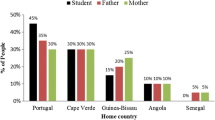Abstract
This research project exemplifies how technology can facilitate scientific investigations. It also highlights how enthusiastic children can be when they are encouraged to pose their own questions and take responsibility for finding the answers. Year 5 children, working in groups, were involved in designing, making and appraising catchers and enclosures used to investigate small animals found within their school's grounds. A videotape of this project was made and should be a valuable resource for the professional development of both trainee and practising teachers. Included in the tape are children's spontaneous comments, their concern for animal welfare, and reflection on the various aspects of their investigations.
Similar content being viewed by others
References
Australian Education Council. (1994).A statement on technology for Australian schools. Carlton, Victoria: Curriculum Corporation.
Baird, J. R., Gunstone, R. F., Penna, C., Fensham, P. J., & White, R. T. (1990). Researching balance between cognition and affect in science teaching and learning.Research in Science Education, 20, 11–20.
Brass, K., & Jobling, W. (1994). Digging into science. In P. Fensham, R. Gunstone, & R. White (eds.),The content of science. A constructigist approach to its teaching and learning (pp. 112–120). London: The Falmer Press.
Driver, R., & Bell, B. (1986). Students' thinking and learning of science: A constructivist view.School Science Review, 67, 443–458.
Driver, R. (1994). Constructivist perspectives on learning science. In P. L. Lijnse (Ed.),European Research in Science Education (pp. 65–74). Proceedings of the first Ph.D. Summerschool.
Erickson, F. (1986). Qualitative methods in research on teaching. In M. C. Wittrock (Ed.),Handbook of research on teaching (3rd ed.). New York: Macmillan.
Fensham, P. J., & Gardner, P. L. (1994). Technology education and science education: A new relationship? In D. Layton (Ed.),Innovations in science and technology education 5 (pp. 159–170). Paris: UNESCO.
Gardner, P. L., Penna, C., & Brass, K. (1990). Technology and science: Meanings and Educational implications.The Australian Science Teachers Journal, 36 (3), 22–28.
Gardner, P. L. (1992). The application of science to technology.Research in Science Education, 22, 140–148.
Gardner, P. L. (1993, January).Science and technology: Rethinking the relationship. Paper presented at the UNESCO/Israel Ministry of Science and Technology sponsored International Conference on Science Education in Developing Countries, Amos de Shalit Israeli Science Teaching Centre, Jerusalem, Israel.
Gilbert, C. (1990).Look, primary technology. Edinburgh: Oliver and Boyd.
Jane, B. L. (1994).Children linking science with technology. Video produced by Course Development Centre Video Production Unit, Deakin University, Burwood Campus Available from Centre for Research in Mathematics, Science and Environmental Education, 221 Burwood Highway, Burwood, Victoria, 3125, Australia.
Kelly, G. A. (1955).The psychology of personal constructs. New York: Norton.
Malcolm, C. (1992).Science teaching and technology. Carlton: Curriculum Corporation.
Malcolm, C., Cole, J., Hogendoorn, R., O'Keefe, D., & Reid, I. (1987).The science framework P-10. Melbourne: Ministry of Education (schools Division), Victoria.
Maruff, E., & Clarkson, P. (1988).The technology studies framework P-10. Melbourne: Ministry of Education (Schools Division), Victoria.
Pramling, I. (1983),The child's conception of learning. In K. Harnqirst, F. Marton & K. G. Stukot (eds.), Goteborg Studies in Educational Sciences. Goteborg, Sweden: ACTA Universities Gothoburgensis.
Shapiro, B. L. (1987).What children bring to light: A study of personal orientation to science learning. Unpublished doctoral dissertation. The University of Alberta, Washington.
Wiersma, W. (1986).Research methods in education: An introduction (4th ed.). Boston: Allyn & Bacon.
Author information
Authors and Affiliations
Corresponding author
Additional information
Syndal South Primary School
Rights and permissions
About this article
Cite this article
Jane, B.L. Children linking science and technology in the primary classroom. Research in Science Education 25, 191–201 (1995). https://doi.org/10.1007/BF02356451
Issue Date:
DOI: https://doi.org/10.1007/BF02356451




